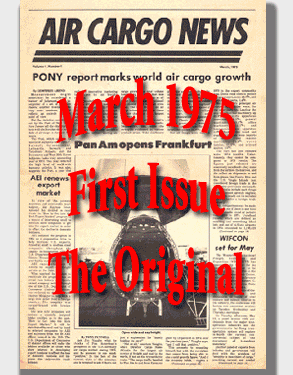| 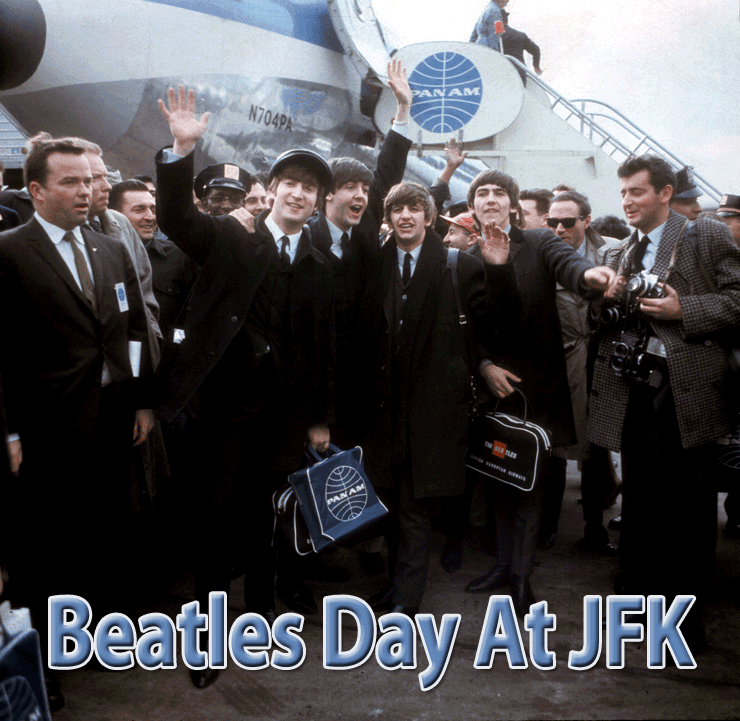
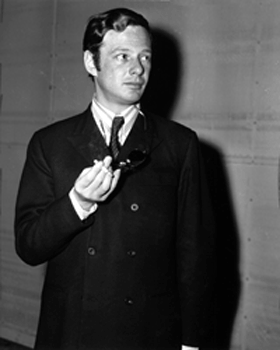  he
mannered manager of the English band whose name few had previously heard
had a message for all those present in the conference room at JFK's International
Arrivals Building (IAB, now Terminal 4). Speaking to mostly seasoned representatives
of Pan American Airways, the Port Authority, and the New York Police Department,
Brian Epstein could not have found an audience less likely to believe
that they were weeks from experiencing a crowd unlike anything they had
seen before. he
mannered manager of the English band whose name few had previously heard
had a message for all those present in the conference room at JFK's International
Arrivals Building (IAB, now Terminal 4). Speaking to mostly seasoned representatives
of Pan American Airways, the Port Authority, and the New York Police Department,
Brian Epstein could not have found an audience less likely to believe
that they were weeks from experiencing a crowd unlike anything they had
seen before.
Mary Ann Trainor had joined Pan Am's public
relations department after moving to New York from Michigan in 1963. She
sat across the table from Epstein in the hours-long planning meeting,
during which the Beatles' movements from aircraft to an on-site press
conference and through curbside departure were plotted in detail.
She recalls Epstein as thoroughly serious
as the assembled representatives discussed which mix of local, national,
and international media would have access to the tarmac and press conference.
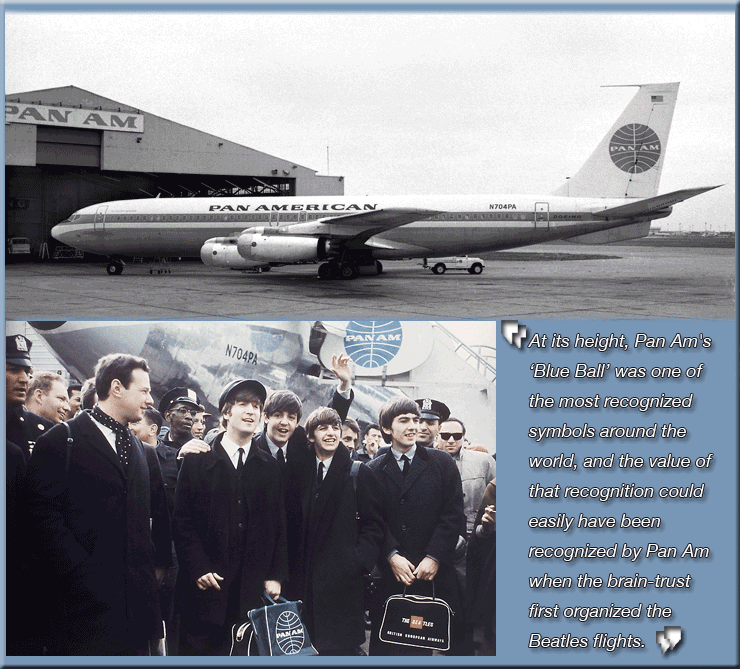 |
Trainor recalls how Epstein (in photo above with polka dot krawatte)—a
man whose classmates had included Albert Finney and Peter O'Toole at the
Royal Academy of Dramatic Arts—confidently repeated his assertion
that no matter how big they could imagine this would be, it would be bigger.
One can easily imagine how such a message went down with a group largely
comprising native New Yorkers. They scoffed, but history validates Epstein's
faith about what would transpire at JFK International Airport a few weeks
later on February 7, 1964.
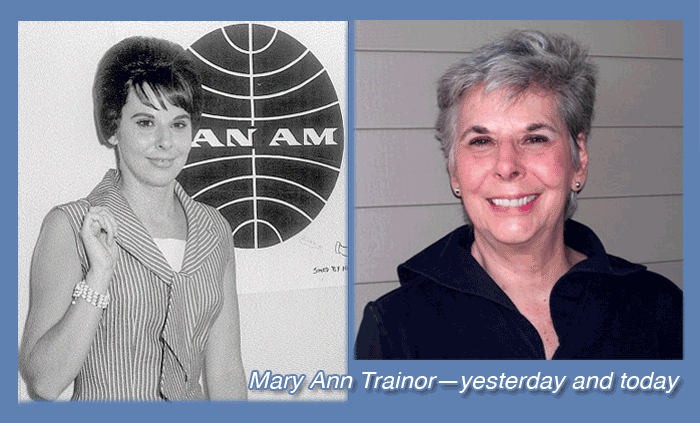 |
If not for a decision made at that planning
meeting, the iconic images of the Beatles descending the stairs from the
Boeing 707 would either not have existed or would have been profoundly
less impressive. Several options could have allowed The Beatles to arrive
more privately obscured from the viewing areas above the IAB but those
in the planning meeting had agreed that they had to give the fans "something."
While he may have been cagey about it, Epstein
relished the kind of massive reception about which he was warning. Rather
than pull closer to the gate, the aircraft Pan Am had named Jet Clipper
Defiance would be parked on the tarmac in full view of the thousands of
fans and gathered media. The scene was repeated—with even more fans
in attendance after the appearances on the Ed Sullivan Show—days
later when the Beatles left JFK for England. Owing to the pandemonium
they had just endured, the Port Authority made a more conservative decision
in 1965 in ordering that the Beatles' aircraft park in a remote location
where the band could deplane into waiting vehicles without creating another
spectacle.
While airfield and roadway access were coordinated
with the Port Authority and NYPD, the Beatles were almost entirely in
the custody of Pan Am from Heathrow through JFK.
| Product Placement
For Generations |
How
exactly the Beatles came to fly Pan Am rather than state-owned British
Overseas Airways Corporation (the same BOAC that was name-checked by Paul
McCartney in the Beatles' "Back in the USSR") remains uncertain.
All of the Pan Am veterans interviewed for
this article believed that Pan Am's brain trust recognized the potential
promotional benefit of operating these flights and took up the challenge
of competing with The Beatles' own national carrier.
Regardless of how much it was Pan Am's good
luck or foresight, it shaped "product placement" for generations.
Pan Am veterans suggested credit might be
placed on the efforts of Richard (Dick) N. Barkle, who frequently seemed
to be involved in such marketing opportunities for Pan Am.
Unfortunately, Mr. Barkle could not be interviewed,
as he passed away in San Francisco on August 7, 2013.
His obituary from the New York Times (published
8/24/13) noted that he had been "responsible for accompanying VIP's
and dignitaries from around the world" during his many years at Pan
Am.
One can scarcely locate a single photo taken
of the Beatles on the airfield in which Pan Am's aircraft and its recognizable
personnel are not clearly visible.
Then
once inside the IAB, the Beatles' press conference was conducted in front
of a wall decorated with the classic Pan Am globes visible on all sides.
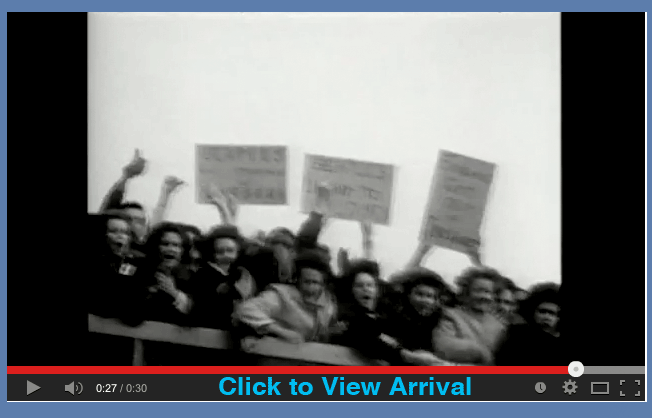 |
Even
when walking, the Beatles can be seen toting clearly labeled Pan Am bags
they would continue to use for the remainder of the trip; photos and news
reels shot later on the trip showed the Beatles carrying newly purchased
records and other bounty from America in these same bags.
By the time the Beatles returned to England,
Pan Am had temporarily renamed its aircraft with a stenciled "Jet
Clipper Beatles" in full view of the photographers and thousands
of fans waiting to see them off at JFK.
Air transportation lecturer, writer, and
consultant Jamie Baldwin maintains a blog about Pan Am and is a coauthor
of the book Pan American World Airways: Aviation History through the Words
of its People. Asked about that association for this article, Baldwin
observed "at its height, Pan Am's ‘Blue Ball’ was one
of the most recognized symbols around the world, and the value of that
recognition could easily have been recognized by Pan Am when the brain-trust
first organized the Beatles flights.
“This has transcended over the years
to the point where it has become an art, through sponsorship, as perfected
by Emirates Airline.
“At nearly every major world-wide
sporting event, the name "Emirates" is strategically placed
for maximum exposure.
“I have to think what Pan Am did during
that February in 1964 was the genesis of what Emirates is doing today."
| Jill Was
Crew Aboard The Flights |
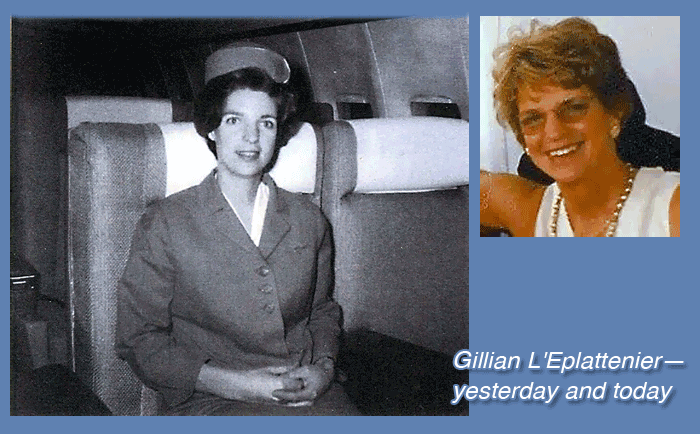 |
Including
the preceding flight from JFK to Heathrow, the Beatles' maiden voyage
to America was only the second commercial flight of Gillian L'Eplattenier
(Jill Kellogg to those who knew her then) as a Pan Am flight attendant.
L'Eplattenier had declined an offer to join
TWA in part because Pan Am would allow her to immediately fly internationally,
while TWA required she first work two years on domestic flights.
Beginning in January 1964, a 24-year-old
L'Eplattenier completed a month's training at Pan Am's training center
in Hangar 14 at JFK; she then had a 2-day break before these flights.
For a newly-trained flight attendant working
in First Class, cause for concern was only elevated by the fact that the
plane had been reconfigured to accommodate 36 (in a 2x2 seat configuration)
passengers in first class, rather than the standard 12-16, to accommodate
the atypical entourage of the Beatles and accompanying media.
L'Eplattenier described the trip in original
interviews for this article, as well as in Baldwin's Pan Am book.
Picked up at their London layover hotel,
L'Eplattenier and the other crew had no unusual anticipations, but noticed
the standard flight crew had been augmented by two stewardesses (the term
flight attendant was still to come).
| Crew Singing
“I Want To Hold Your Hand” |
Only
as the bus left the hotel did the crew's first officer slip on a Beatles
mask and begin (poorly, in L'Eplattenier's opinion) singing "I Want
to Hold Your Hand" before teasing "Guess who we have on board
with us today?!"
Rather than revel in the excitement about
to come, L'Eplattenier spent the trip to Heathrow recalling all of her
training.
The crew boarded the plane to check provisions
and as she reconciled Pan Am's meticulous attention to meal preparation
and service "with elegance and grace" with the dramatically
increased number of First Class passengers, her primary concern was not
her famous guests but "Oh, my God, what an enormous number of people
for whom we would have A-1 service."
The range of specially prepared entrees
available in Pan Am's First Class elicited an "I'll take whatever"
response, in the manner of being unaccustomed to such choices, rather
than being dismissive.
These Beatles had wrapped up their final
two-week residency at Hamburg's Star Club in that city's infamous Reeperbahn
only 13 months earlier.
Epstein had replaced their leather gear
with suits and compelled them to stop eating, smoking and swearing on
stage.
Fame was relatively new.
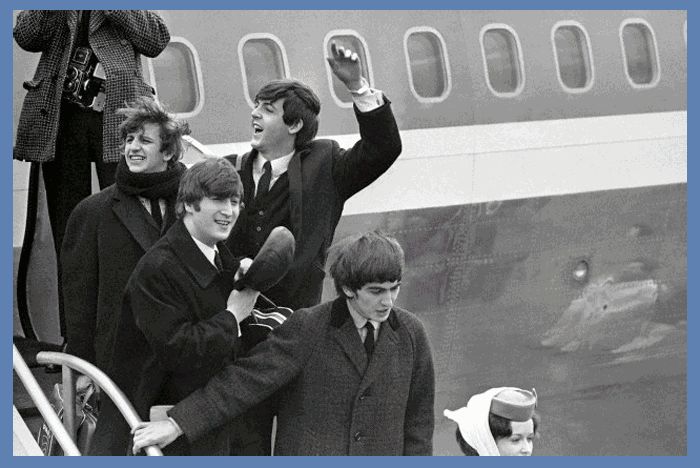 |
The
oldest Beatles—John Lennon and Ringo Starr—were only 23, while
Paul McCartney was 21 and George Harrison only 20. Previous international
touring had mostly involved a van, a ferry, and that same van again.
These Beatles were decidedly working class.
Only McCartney had actually graduated from high school, although Lennon
had briefly been granted admission to art college based on his innate
artistic abilities. L'Eplattenier was most impressed by McCartney, who
comfortably interacted with passengers and crew alike.
In full tourist mode, McCartney took a photo
of L'Eplattenier and she has always wished she could have had a copy of
the image shot by one of the most photographed people of their generation.
Harrison and Starr also enjoyed themselves,
moving around and talking with other passengers, while Lennon was traveling
with his wife Cynthia.
The couple stayed mostly to themselves,
although photos show them with record producer Phil Spector, who was also
on the flight.
Spector would later produce The Beatles'
Let It Be and solo records by Harrison and Lennon.
First
Class and Economy aboard that fabled Pan Am flight were clearly separated,
but stewardesses in Economy shuttled menus to stewardesses in First Class
to be autographed by The Beatles who obliged gamely, even as their own
staffer, Mal Evans, sat in Economy forging their autographs on promotional
photos that would be distributed in the U.S.
| Atmosphere
Was Electric Arrival Meteoric |
L'Eplattenier
still recalls the electric atmosphere of the onboard trip and (happily)
no exhibition of attitude or entitlement by the four young men who made
the beginning of her Pan Am career singularly memorable. On landing, cheers
broke out within the aircraft, but that was nothing compared to the noise
already audible from the awaiting terminal at JFK, where thousands of
young girls could already be heard singing the fictional Conrad Birdie-inspired
song "We love you, Beatles. Oh yes we do."
In photos and footage of the Beatles arrival
at JFK, she is clearly visible standing on the right hand side of the
First Class cabin door as the Beatles disembarked. Asked if she told them
"goodbye" or "good luck" after hours of serving them,
L'Eplattenier acknowledged that the overwhelming excitement of the precise
moment that the Beatles met their American public made that nearly impossible,
but moreover, the sound of the fans up on the observation deck was so
deafening that the Beatles may not have heard her standing only a foot
away in that incredible moment.
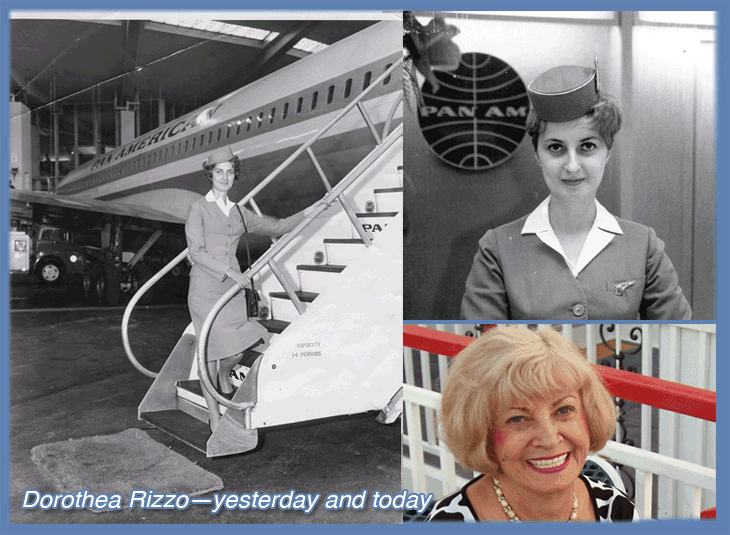 |
Once the aircraft had been parked on the tarmac, Pan Am's Special Services
(VIP) representative Dorothea Rizzo boarded the plane, bringing with her
a porter to assist with the Beatles' luggage.
Rizzo introduced herself and each Beatle
introduced himself and then identified his bags to the porter.
Interviewed for this article, Dorothea spoke
warmly of her impression of her famous customers.
Although still in their twenties in 1964,
all of the Pan Am representatives interviewed for this article were older
than any of The Beatles.
Rizzo observed that they "looked like
little boys" but she admired "how neatly combed they were, well
scrubbed and with mod suits."
Reinforcing the impression L'Eplattenier
formed from the Beatles' entree orders of "whatever," Rizzo
observed that when asked if they had any special requests from VIP services,
the four had none.
"You would want to have a son like
that," was how Rizzo summed up her impression of how the Fab Four
handled the almost unimaginable situation unfolding in front of them.
Rizzo enjoyed that, unlike celebrities who
seem compelled to act unimpressed, these four boys were clearly exhilarated
by the clamor of the crowd, but still unfailingly polite and "laid
back" to the professionals whose jobs entailed serving them.
After posing for photos on the stairs and
tarmac, the Beatles entered the International Arrivals Building for processing
by Customs, Immigration, and Health Services.
Already
sick with strep throat that would prevent him from participating in the
Ed Sullivan Show rehearsals, George Harrison asked right away on the tarmac
if the four could speed up the process, but was told that The Beatles
would have to wait until supervisors signaled it was alright to enter
the building.
Following regulatory clearances, the Beatles
would advance to a press conference in IAB's press lounge.
That legendary press conference can be found
in its entirety in full-length documentaries and in clips on youtube (click
below).
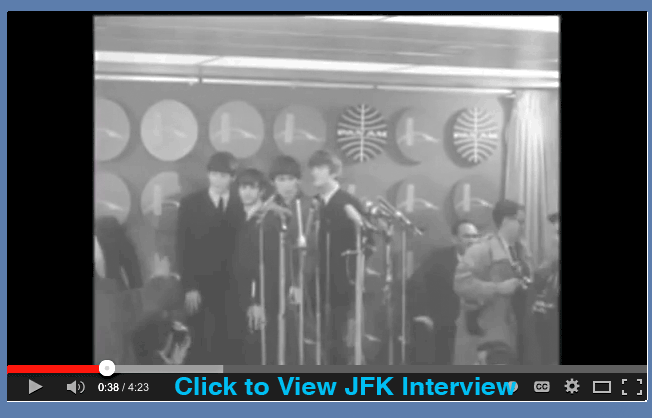 |
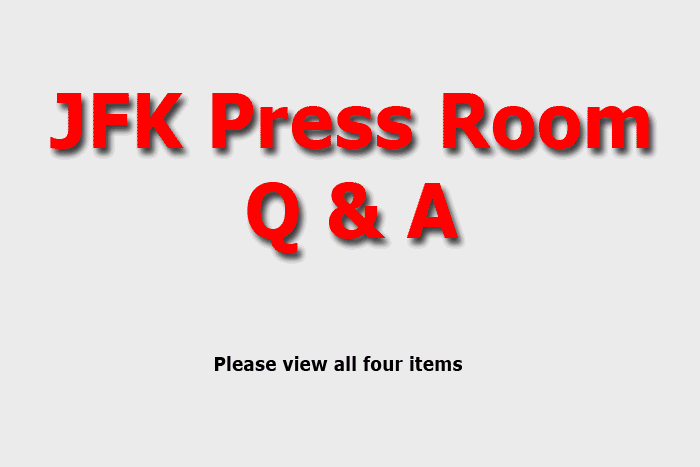 |
Following the press conference, the Beatles left JFK for the Plaza Hotel
in Manhattan. One limousine ferried McCartney, Harrison, and Starr. Lennon
and his wife Cynthia took another. Epstein, Neil Aspinall, and Mal Evans
simply hailed a taxi.
In the Beatles Anthology, McCartney recalled:
"I remember, the great moment of getting
into the limo and putting on the radio, and hearing a running commentary
on us:
‘They have just left the airport and are
coming towards New York City...' It was like a dream. The greatest fantasy
ever." Also in the Anthology, Ringo Starr recalled, "it was
so exciting.
“On the plane, flying into the airport,
I felt as though there was a big octopus with tentacles that were grabbing
the plane and dragging us down into New York.
“America was the best.
“It was a dream, coming from Liverpool."
| Product Of
A Tough Environment |
In almost every respect, the Beatles of 1964 had been shaped by a couple
of tough port cities —their native Liverpool and their adopted Hamburg.
In 1964, London wasn't quite swinging yet, but
far more cosmopolitan than the Beatles' hometown.
In terms of the popular music business, it is
not mere jingoism to suggest there was America and then everything else.
In Philip Norman's classic Beatles biography
Shout, George Harrison recalled his attitude about America on boarding
Pan Am Flight 101 in terms of "they've got everything over there.
“What do they want us for?"
| The Genius
Of Brian Epstein |
The
doubt informing Harrison's concern and other Beatles' claims that they'd
be lucky if their success lasted a year was not shared by their manager,
Brian Epstein. While only anticipating their arrival a few weeks later,
Epstein's told the IAB conference room full of New York reporters that
whatever they expected, it would be bigger than that.
The Beatles sound was the product of thousands
of hours played in homes and clubs, but their appearance was the product
of the refined tastes of Epstein.
Their wit and charm are often claimed by the
working class citizens of their hometown, and anyone who has been to Liverpool
might find merit in that claim. From all accounts, the four young men
about to appear on the Ed Sullivan Show were as polite and unassuming
as anyone flying in First Class that day.
| Everything
Changed After That Day At JFK |
This was a new world for them and it's tempting to wonder who was changed
more when Flight 101's cabin door opened that day at JFK—the emerging
generation of Americans or The Beatles. I'd call it a draw.
| Defiance
Flew Into History |
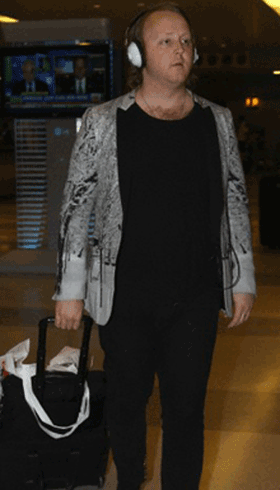 The
Boeing 707-331 (N704PA) that transported the Beatles was given the name
Clipper Defiance when delivered to Pan Am on March 23, 1960. The
Boeing 707-331 (N704PA) that transported the Beatles was given the name
Clipper Defiance when delivered to Pan Am on March 23, 1960.
In 1972, Pan Am leased the aircraft to World
Airways for a few months before placing it in storage.
Its final scheduled commercial user was Air Vietnam, to whom Pan Am first
leased and then sold it on December 21st, 1973.
On August 13th, 1975, Pan Am repossessed
the airframe from Air Vietnam and sold it a few months later to Aircraft
Radio, Inc.
In June 1977, it was finally scrapped at
Long Beach, California.
Bit Less Frenetic
. . . James McCartney, son of Paul and the late Linda McCartney at JFK
International recently.
The former International
Arrivals Building (IAB) was replaced by the current Terminal 4 in 2001.
The Pan Am terminal (Terminal 3, also known as
the Worldport) did not have customs and immigration capabilities until
an expansion completed in 1971.
On their return trip on February 21, 1964, the Beatles first arrived on
a domestic flight from Miami and then boarded
their aircraft, again a Pan Am 707 renamed "Jet Clipper Beatles"
for the occasion, from under the Pan Am Terminal's umbrella roof. The
Pan Am Worldport was demolished in late 2013.
John Lennon and George Harrison have passed.
So have Brian Epstein (in 1967) and Ed Sullivan (1974),.
As have many more Pan Am professionals, including
Mary Ann Trainor's beloved late husband Patrick Trainor, who was Pan Am's
manager at the IAB.
Pan American World Airways itself no longer exists,
having gone bankrupt in 1991. But fortunately the airline’s loyal
staff has continued to serve honorably, to keep the name and most fabulous
history of the iconic pioneer airline alive.
| Pan Am People
Most Proud Of Their Lives |
The Pan Am professionals
interviewed for this article counted themselves as fortunate to have briefly
shared in the Beatles story, but were most proud of the families they
had raised, and efforts such as Gillian L'Eplattenier's charitable work
with the Manhattan Chapter of World Wings, which raised money for the
burn unit of a New York Hospital, and Mary Ann Trainor's recent service
to a Homeless Ministry in Michigan.
The Pan Am folks share one of the greatest cocktail
stories of the twentieth century, but they have defined themselves on
their own merits.
Reasonable efforts have been made to substantiate
the details presented herein. Even after 50 years, some details presented
herein may be new and even surprising to scholars.
The accounts presented here accurately depict
the memories of the interviewees.
Michael Webber
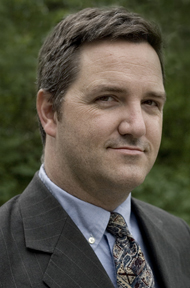 A
postscript: Michael Webber is a much-sought after, totally professional
air cargo consultant who—fortunately for us—also loves good
music. A
postscript: Michael Webber is a much-sought after, totally professional
air cargo consultant who—fortunately for us—also loves good
music.
He was born in Kansas City, Missouri,
in March, 1964, about a month after the events here occurred.
Until late 1963, Mike’s parents
and older siblings lived outside of London where his father was stationed
while serving in the U.S. Air Force.
Webber's mom was a Beatles fan who recalls
listening to the group as they became famous on a daily BBC radio request
program known as “Housewives' Choice.”
In June 1992 Webber's mother observed
the occasion of Paul McCartney turning 50 made her feel older than when
she had turned 50 four years earlier.
Now Michael Webber is turning 50 in
March 2014.
He was raised around music, but the
first record he ever requested was a 45 of "Hey Jude" in 1968,
when he was 4 years old.
As his writings here for FlyingTypers
indicate, Mike has lost none of his enthusiasm for Beatles music. (Geoffrey)
|







